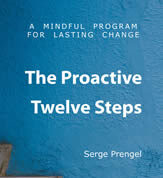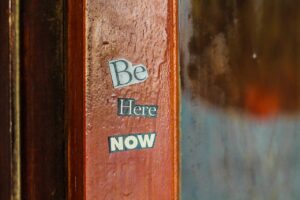
The Proactive Twelve Steps
“The attempt to escape from pain, is what creates more pain.”
ҥ Gabor Mat̩
This is a first. I started writing a review of a trusted and valued colleague’s text and discovered that much of the material, including detailed resources and information that can truly help readers, was accessible online, for free. Honestly, I have prayed for colleagues to offer their knowledge, their clinical expertise, their methodology, and experientials to readers/clients for free during these tumultuous times. We are immersed in a strange vibrational resonance with traditional approaches to health facing multiple challenges. Serge Prengel is willing to show up for people without a personal agenda, without strings attached. His knowledge and support have the potential to help people initiate lasting changes to improve the quality of their lives.
In this light, I offer a brief introduction about the book and then links to hopefully save time-starved readers and perhaps some frazzled readers from investing time in my thoughts about Serge’s revised edition and what’s involved. If we can cut straight to the chase and get this material out to people who can benefit from it, all the better. From there, I share my thoughts on why this is a useful book to purchase, read/experience, and share with other people.
A brief look borrowing many of Serge’s words
The Proactive Twelve Steps, 6th Edition, teach readers how to transition from feeling stuck and powerless to enjoying a balanced and happy life. The steps offer a revised perspective built on the original Twelve Steps developed by Bill Wilson and Bob Smith (Alcoholics Anonymous founders). While Serge offers an alternative version without a reliance on God, the book is not just for atheists and agnostics; it is for anyone who wants to make sense of how change happens. Serge describes the steps as a mindful program instead of a mystical experience in which change somehow happens to you when you release your control to a higher power and let this power source purge you of your sins and moral defects (of character).
The Proactive Twelve Steps offers readers a way to develop a deeper understanding of behavioral change, codependency, stress, and trauma, as well as look at neuroscience and the Polyvagal Theory and their impact on our physiology and behavior. Serge presents a clear roadmap for self-compassion and mindful self-discovery and provides specific step-by-step instructions within a broader context that helps readers make sense of the healing process.
In short, this book is “a user-friendly guide to the application of mindfulness in everyday life”.
To read the entire review, please click here to access the PDF
To Jump Right In Here are Links
The Proactive Twelve Steps and a discussion of each step are available at www.proactive12steps.com.
You can follow Serge’s work on Facebook Twitter and YouTube.
You can follow the Proactive 12 Steps podcast from your phone, on Apple Podcasts and on other podcast apps.
You can also access his newsletter here: https://www.proactive12steps.com/newsletter/.
He offers numerous articles online:
How to work the 12 steps online workbook
The mindful process of change in Steps 4 through 10
Codependency: Symptoms of codependent behavior in relationships
Higher Power as Inner Power: Lasting change from inside out
An ecosystem for mindful self-discovery & recovery
For people who are in recovery, Serge offers the following resources for people seeking kindred companions on the journey to living an alcohol-free life:
““ AA Agnostica
““ AA Beyond Belief
In My Opinion: One Reader’s Experience
For those interested in the book and what I think, I offer the following review.
To start, I believe that there is no one form or kind of addiction, no one single cause. Some claim addiction is a medical disease, others cite it as a mental/emotional/spiritual concern. Addiction takes on whatever shape, form, intensity that serves the person living with the experience. Some say the brain remembers and no matter what one does to stop, one false step and wham you are back in the muck, mired in a destructive relationship with seemingly no way out. Frankly, there is no ‘right way’ to treat addiction.
When Bill Wilson met Bob Smith, their synergy resulted in Alcoholic Anonymous. Bill stressed that alcoholism was “a malady of mind, emotions, and body.” He believed that humans could not solve their addictions alone. The process needed to include both community (i.e., AA meetings, books, and the twelve steps) and a belief in a higher power, something beyond themselves to turn over their essence for forgiveness and be given the power (courage, wisdom, serenity) to move beyond needing to drink. God was the chosen one.
Serge’s book is about the practice of being human and living with human concerns dealing with addiction. His mindful process of self-discovery is a path to lasting change. His goal in writing and revising the book was to describe the original twelve steps in a way that grounded the healing process within ourselves. Readers have the chance to learn how to make change not only possible but also to happen. Serge believes that we don’t change by giving our power away to some energy outside ourselves but rather by making conscious changes in the way we live and relate to ourselves and to other people.
The proactive steps are suitable for anyone wanting to adopt a mindful, proactive approach to change (this version has nothing to do with faith, religion, belief, or not in God). Serge explains that addiction is not about sin or moral defects but rather a means to an end, a way to cope with trauma/abuse/whatever overwhelming experience that we lacked the skills to deal with.
According to Serge, the core of the book is Part 1: Step by Step. Reading the book is like taking part in a workshop. Readers are called on to do the work, to be an active participant, one step at a time rather than by simply reading through it as if the material will simply be internalized and change will occur. Serge encourages doing this with someone, with a group perhaps (he offers advice for working with a group in Appendix 2). He suggests readers take time to be with each step and offers advice in his chapter: How to Walk the Walk.
The process is not supposed to be harsh or intense. It is designed to be a gentle process of self-discovery, simply being with yourself compassionately and exploring, watching, wondering. Serge encourages readers to keep a journal and track their experiences and feelings and outcomes. The experience is meant to help readers be proactive and reflective, to create a mindful orientation toward their felt experience, a quality, Serge notes we want to cultivate in our present life.
To read the entire review, please click here to download the PDF
Photo Credits
Man alone and next step by Gerd Altmann from Pixabay
Be here now by Harald Lepisk from Pixabay



